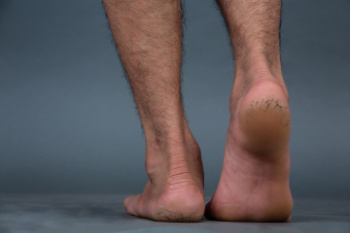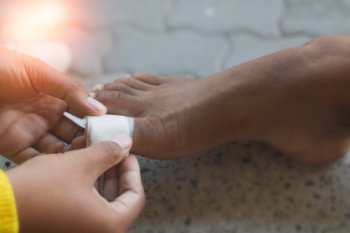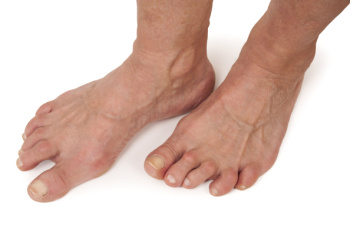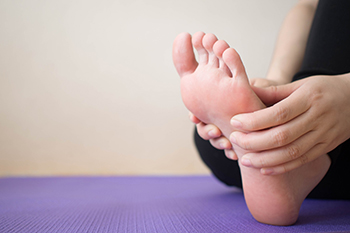Connect With Us
Blog
Items filtered by date: July 2025
Cracked Heels and Discomfort

Cracked heels occur when the skin on the heel becomes dry, thick, and splits open. This condition is often caused by prolonged standing, open-back shoes, dry weather, or lack of moisturizing foot care. Risk factors include obesity, diabetes, and skin conditions like eczema. Symptoms include rough skin, visible cracks, itching, and pain during walking. Cracks hurt because pressure on the heel causes the dry skin to split deeper, exposing sensitive tissue. A podiatrist can provide professional treatment to remove thick skin, promote healing, and prevent infection. This type of doctor can recommend custom creams, proper footwear, and preventive care. If cracked heels are causing discomfort or bleeding, it is suggested that you promptly visit a podiatrist who can offer effective treatment solutions, which may include prescribed medication.
If the skin on your feet starts to crack, you may want to see a podiatrist to find treatment. If you have any concerns, contact Michael Schwartzman, DPM from Illinois and Indiana . Our doctor can provide the care you need to keep you pain-free and on your feet.
Cracked Heels
It is important to moisturize your cracked heels in order to prevent pain, bleeding, and infection. The reason cracked heels form is because the skin on the foot is too dry to support the immense pressure placed on them. When the foot expands, the dry skin on the foot begins to split.
Ways to Help Heal Them
- Invest in a good foot cream
- Try Using Petroleum Jelly
- Ease up on Soaps
- Drink Plenty of Water
Ways to Prevent Cracked Heels
- Moisturize After Showering
- Skip a Shower
- Keep Shower Water Lukewarm
- Don’t Scrub Your Feet
If you are unsure how to proceed in treating cracked heels, seek guidance from a podiatrist. Your doctor will help you with any questions or information you may need.
If you have any questions, please feel free to contact our offices located in West Chicago, IL and Whiting, IN . We offer the newest diagnostic and treatment technologies for all your foot care needs.
Keep Your Feet Healthy So You Can Stay Active
Blisters and Corns Are Small Issues That Cause Big Discomfort

Blisters, corns, and calluses may seem minor, but they can cause significant foot discomfort. Blisters are fluid-filled pockets caused by friction, often from wearing tight shoes or taking long walks. Corns are small, hardened areas typically found on toes, while calluses are thicker patches of skin on the soles, both caused by repeated pressure or rubbing. These conditions may look like raised, thickened, or rough skin and can feel tender, painful, or irritated, especially when walking or wearing shoes. A podiatrist can treat them by gently removing thickened skin, draining blisters when necessary, and recommending proper footwear or orthotics to prevent recurrence. While these issues are common, people with diabetes or poor circulation are at a higher risk for complications, as minor skin problems can quickly lead to serious infections. If you have any of these conditions, it is suggested that you schedule an appointment with a podiatrist for appropriate treatment.
Blisters are prone to making everyday activities extremely uncomfortable. If your feet are hurting, contact Michael Schwartzman, DPM of Illinois and Indiana . Our doctor can provide the care you need to keep you pain-free and on your feet.
Foot Blisters
Foot blisters develop as a result of constantly wearing tight or ill-fitting footwear. This happens due to the constant rubbing from the shoe, which can often lead to pain.
What Are Foot Blisters?
A foot blister is a small fluid-filled pocket that forms on the upper-most layer of the skin. Blisters are filled with clear fluid and can lead to blood drainage or pus if the area becomes infected.
How Do Blisters Form?
Blisters on the feet are often the result of constant friction of skin and material, usually by shoe rubbing. Walking in sandals, boots, or shoes that don’t fit properly for long periods of time can result in a blister. Having consistent foot moisture and humidity can easily lead to blister formation.
Prevention & Treatment
It is important to properly care for the affected area in order to prevent infection and ease the pain. Do not lance the blister and use a Band-Aid to provide pain relief. Also, be sure to keep your feet dry and wear proper fitting shoes. If you see blood or pus in a blister, seek assistance from a podiatrist.
If you have any questions, please feel free to contact our offices located in West Chicago, IL and Whiting, IN . We offer the newest diagnostic and treatment technologies for all your foot care needs.
Early Signs of Rheumatoid Arthritis in the Feet

Rheumatoid arthritis in the feet is an autoimmune condition that causes the immune system to attack joint tissues, leading to pain, swelling, and stiffness. It often affects the small joints in the toes and midfoot, making walking painful and limiting mobility. Causes are linked to genetic and environmental factors that trigger inflammation. Symptoms include joint tenderness, warmth, deformities, and a reduced range of motion. Risk factors include a family history of autoimmune conditions, smoking, and age. A podiatrist can help by identifying early changes, providing supportive care with custom orthotics, and footwear advice. If you notice persistent joint pain or swelling in your feet, it is strongly suggested that you promptly visit a podiatrist for an early diagnosis and effective pain management.
Because RA affects more than just your joints, including the joints in your feet and ankles, it is important to seek early diagnosis from your podiatrist if you feel like the pain in your feet might be caused by RA. For more information, contact Michael Schwartzman, DPM of Illinois and Indiana . Our doctor will assist you with all of your podiatric concerns.
What Is Rheumatoid Arthritis?
Rheumatoid Arthritis (RA) is an autoimmune disorder in which the body’s own immune system attacks the membranes surrounding the joints. Inflammation of the lining and eventually the destruction of the joint’s cartilage and bone occur, causing severe pain and immobility.
Rheumatoid Arthritis of the Feet
Although RA usually attacks multiple bones and joints throughout the entire body, almost 90 percent of cases result in pain in the foot or ankle area.
Symptoms
- Swelling and pain in the feet
- Stiffness in the feet
- Pain on the ball or sole of feet
- Joint shift and deformation
Diagnosis
Quick diagnosis of RA in the feet is important so that the podiatrist can treat the area effectively. Your doctor will ask you about your medical history, occupation, and lifestyle to determine the origin of the condition. Rheumatoid Factor tests help to determine if someone is affected by the disease.
If you have any questions, please feel free to contact our offices located in West Chicago, IL and Whiting, IN . We offer the newest diagnostic and treatment technologies for all your foot care needs.
Plantar Fasciitis Is a Common Cause of Heel Pain

Plantar fasciitis is a leading cause of heel pain, caused by small tears and inflammation in the plantar fascia, a thick band of tissue connecting the heel to the toes. It is often triggered by overuse, flat feet, tight calf muscles, or footwear with inadequate support. While it is commonly known for morning heel pain, a lesser-known symptom is arch tightness or burning sensations after long periods of standing. It typically feels like a sharp, stabbing pain in the heel or arch, especially with the first steps in the morning or after rest. Visibly, there may be no swelling, but the pain can significantly affect daily activities. A podiatrist can diagnose plantar fasciitis with a physical exam and a review of your symptoms and activity level. Treatment includes stretching, orthotics, supportive shoes, targeted exercises, and occasionally injections. If you are dealing with this condition, it is suggested that you make an appointment with a podiatrist for evaluation and treatment.
Plantar fasciitis is a common foot condition that is often caused by a strain injury. If you are experiencing heel pain or symptoms of plantar fasciitis, contact Michael Schwartzman, DPM from Illinois and Indiana . Our doctor can provide the care you need to keep you pain-free and on your feet.
What Is Plantar Fasciitis?
Plantar fasciitis is one of the most common causes of heel pain. The plantar fascia is a ligament that connects your heel to the front of your foot. When this ligament becomes inflamed, plantar fasciitis is the result. If you have plantar fasciitis you will have a stabbing pain that usually occurs with your first steps in the morning. As the day progresses and you walk around more, this pain will start to disappear, but it will return after long periods of standing or sitting.
What Causes Plantar Fasciitis?
- Excessive running
- Having high arches in your feet
- Other foot issues such as flat feet
- Pregnancy (due to the sudden weight gain)
- Being on your feet very often
There are some risk factors that may make you more likely to develop plantar fasciitis compared to others. The condition most commonly affects adults between the ages of 40 and 60. It also tends to affect people who are obese because the extra pounds result in extra stress being placed on the plantar fascia.
Prevention
- Take good care of your feet – Wear shoes that have good arch support and heel cushioning.
- Maintain a healthy weight
- If you are a runner, alternate running with other sports that won’t cause heel pain
There are a variety of treatment options available for plantar fasciitis along with the pain that accompanies it. Additionally, physical therapy is a very important component in the treatment process. It is important that you meet with your podiatrist to determine which treatment option is best for you.
If you have any questions, please feel free to contact our offices located in West Chicago, IL and Whiting, IN . We offer the newest diagnostic and treatment technologies for all your foot care needs.
Common Foot Problems and What Causes Them

Many people experience foot problems that affect daily comfort and mobility. Athlete's foot is a fungal infection caused by moisture and poor hygiene, leading to itching and peeling skin. Bunions are bony bumps that form at the base of the big toe, often from wearing ill-fitting shoes or inherited foot structure. Corns develop from repeated pressure or friction and can become painful over time. Additionally, plantar fasciitis results from inflammation of the tissue along the bottom of the foot, often linked to overuse or poor arch support. A podiatrist can accurately diagnose these conditions, provide effective treatment, and offer guidance on prevention. If you have foot pain, it is strongly suggested that you promptly consult a podiatrist for a personalized treatment plan.
Foot Pain
Foot pain can be extremely painful and debilitating. If you have a foot pain, consult with Michael Schwartzman, DPM from Illinois and Indiana . Our doctor will assess your condition and provide you with quality foot and ankle treatment.
Causes
Foot pain is a very broad condition that could be caused by one or more ailments. The most common include:
- Bunions
- Hammertoes
- Plantar Fasciitis
- Bone Spurs
- Corns
- Tarsal Tunnel Syndrome
- Ingrown Toenails
- Arthritis (such as Gout, Rheumatoid, and Osteoarthritis)
- Flat Feet
- Injury (from stress fractures, broken toe, foot, ankle, Achilles tendon ruptures, and sprains)
- And more
Diagnosis
To figure out the cause of foot pain, podiatrists utilize several different methods. This can range from simple visual inspections and sensation tests to X-rays and MRI scans. Prior medical history, family medical history, and any recent physical traumatic events will all be taken into consideration for a proper diagnosis.
Treatment
Treatment depends upon the cause of the foot pain. Whether it is resting, staying off the foot, or having surgery; podiatrists have a number of treatment options available for foot pain.
If you have any questions, please feel free to contact our offices located in West Chicago, IL and Whiting, IN . We offer the newest diagnostic and treatment technologies for all your foot care needs.

